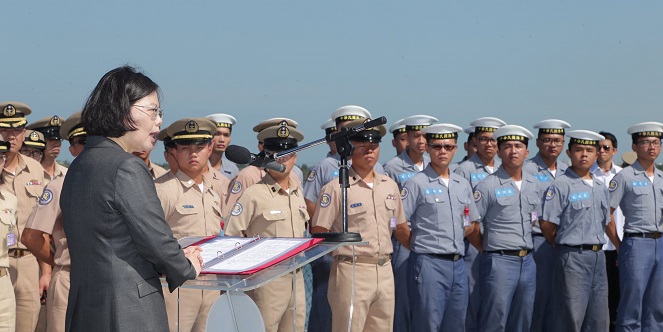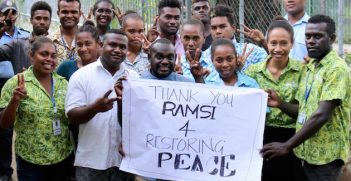Taiwan’s South China Sea Dilemma

Taiwan’s complex history continues to complicate its claims over the South China Sea. Last week’s tribunal decision comes at the right time for newly inaugurated President Tsai to rethink Taiwan’s policy while carefully calibrating its relationships with China and the US.
Last week’s tribunal ruling on the South China Sea rocked the political landscape in Taiwan. The decision found the largest natural feature in the disputed Spratly Islands, the Taiwanese-held Taiping Island (Itu Aba), was a “rock” rather than an island and did not qualify for a 200-nautical mile exclusive economic zone. It also rejected China’s historical nine-dash line, which was inherited and modified from Taiwan’s eleven-dash line claims.
Strong Response from the Tsai Administration
Despite Taiwan having a long history of emphasising multilateral negotiations and peaceful approaches toward maritime disputes, especially the South China Sea Peace Initiative proposed by the administration of former president Ma Ying-jeou in May 2015, the Democratic Progressive Party (DPP)-led Taiwanese government rejected the results of the ruling almost immediately. President Tsai Ing-wen said the result “has seriously hurt our rights to the South China Sea islands and their relevant waters”. The day following the decision, she boarded one of Taiwan’s La Fayette-class frigates, encouraging the crew to “defend Taiwan’s national interest” before they set off on a patrol to Taiping Island. This week, a bipartisan group of Taiwanese legislators visited the island. Having been denied participation in the legal process, the Taiwanese government has declared The Hague ruling has no binding effect on Taiwan, while deeming the term “Taiwan Authority of China” used in the award unacceptable.
Taiwan’s “Chinese” Claims in the South China Sea
When referring to the South China Sea, the dilemma in Taiwan has always been how to distinguish its claims from those of the People’s Republic of China. In Taiwan’s official Position Paper on the Republic of China South China Sea Policy, it describes the historical presence of the Chinese and the continuing exercise of jurisdiction by Chinese dynasties in the region.
But while the ongoing struggle over national identity continues in Taiwan, these historical methods of claiming rights over the South China Sea are coming under serious debate in the island state, with Tsai’s administration considering ending the use of historical rights as a foundation for legal claims in the disputed seas. Observing statements given by Taiwan’s Ministry of Foreign Affairs after the ruling, the eleven-dash line has not been mentioned. This is a possible prologue to Taiwan changing the legal basis of its claims from historical rights or historic waters to sovereignty over the islands, opening future possibilities for participation in South China Sea-related multilateral mechanisms.
Ma’s Effort to Amplify Taiwan’s Claims
In the last few months of the Ma Ying-jeou administration, Taiwan played an increasingly active role in promoting its claims in the South China Sea. Despite not being able to take part in the legal process, the Chinese (Taiwan) Society of International Law was able to submit an amicus curiae in March, to try to convince the five judges that Taiping Island was worthy of being classified as an island under the United Nations Convention on the Law of the Sea (UNCLOS) criteria. Taiwan invited journalists and scholars on inspection trips, while President Ma also paid a visit to the island shortly before leaving office in May. Ma has constantly reiterated that Taiping Island has abundant freshwater (so called “Taiping Water”) as well as fertile soil that nourishes fruits and vegetables and locally bred chickens and goats, which together prove the island’s capacity to sustain economic life on its own.
However, all this evidence of Taiping Island’s “island” status according to UNCLOS criteria didn’t prevent the international tribunal from ruling that there were no island features in the South China Sea. Ma publicly criticised the ruling and called on President Tsai to take stronger actions to reinforce Taiwan’s sovereign rights.
Tsai’s Difficult Manoeuvre
“Chinese people across the strait are duty-bound and obliged to jointly preserve the ancestral land of the Chinese nation,” said Lu Kang, a spokesperson for the Chinese Ministry of Foreign Affairs in response to Taiwan’s rejection of the arbitration.
The statement pretty much sums up Taiwan’s tricky position on the South China Sea dispute. While Ma had largely improved relations with China throughout his two terms, Tsai’s administration has been struggling to maintain sufficient communication channels and establish middle ground between her pro-independence DPP and Beijing. The South China Sea issue has been perceived as one of the few platforms left that both sides can cooperate on, which partially explains Tsai’s strong take on the ruling.
However, Tsai’s recent statements aimed at China have also generated negative responses from Taiwan’s main source of protection, the US. This dilemma, between maintaining moderate ties with China and attracting support from the US, has created troubled waters for Tsai; this situation will probably not end anytime soon. As Taiwan struggles to navigate an international environment shaped by global competition between China and the US, ironically one of the government’s possible policy options will be to remain a vocal supporter of international law, hoping for positive results to defend itself from hostile neighbours, while fending off growing criticism from internal factions.
Jeremy Chiang is currently undertaking an internship at the AIIA National Office. He is a student at National Chengchi University (Taiwan) studying for a bachelor’s degree in diplomacy and history, with a devoted interest in Southeast Asian politics. This article is published under a Creative Commons License and may be republished with attribution.





